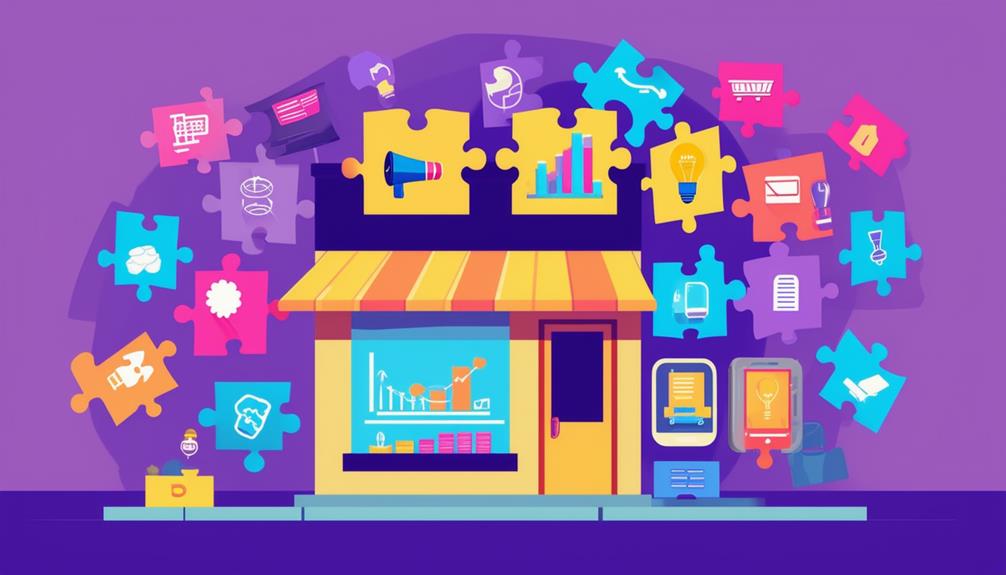
You can boost your small business's visibility and drive sales by implementing a combination of the following marketing strategies. Leverage social media platforms to tap into a massive user base, and create high-quality visual content to set your brand apart. Utilize customer feedback to enhance your brand reputation and loyalty, and implement SEO optimization tactics to improve your search engine rankings. Collaborate with influencers to tap into pre-existing engaged followers, and develop local marketing strategies to target your audience. Build email marketing campaigns, run pay-per-click advertising, and engage in content marketing to showcase your products or services. To take your marketing game to the next level, discover how to implement these strategies effectively.
Leverage Social Media Platforms
By leveraging social media platforms, you can tap into a massive user base, with billions of potential customers waiting to discover your small business. As a small business owner, you can't afford to ignore the power of social media.
By engaging with your customers directly on platforms like Facebook, Instagram, and Twitter, you can build a community around your brand and foster customer loyalty. But that's not all – running targeted ads on social media allows you to reach specific demographics and increase engagement.
For instance, if you're a boutique clothing store, you can target young adults who've shown interest in fashion. By analyzing social media analytics, you can gain insights into customer preferences and optimize your marketing strategies.
Consistently posting high-quality content can drive traffic to your website and increase brand awareness. Don't underestimate the power of social media engagement and targeted advertising – it's a winning combination for small businesses looking to grow their online presence.
Create High-Quality Visual Content
What sets your brand apart from the competition is the quality of your visual content, which can make or break your social media presence. As a small business owner, you know how important it is to stand out in a crowded online space. Investing in high-quality visual content can be a game-changer for your brand.
High-quality visual content increases brand appeal and engagement on social media platforms. Professional imagery helps small businesses stand out and attract a larger audience. Visual content is more likely to be shared and remembered by consumers, leading to increased brand recognition.
Utilizing stock photos from reputable websites can enhance the overall visual appeal of marketing materials. Quality design elements in visual content help differentiate a small business from its competitors.
Utilize Customer Feedback
You can greatly enhance your brand's reputation and loyalty by actively soliciting and incorporating customer feedback into your marketing strategy and business operations. By doing so, you'll gain valuable insights to improve your products and services, ultimately driving customer satisfaction.
Conducting regular customer surveys helps you collect feedback, which can be analyzed to identify areas of improvement. This feedback analysis enables you to make data-driven decisions, leading to continuous improvement and increased customer loyalty.
Positive testimonials and reviews can also be used in your marketing materials, reinforcing your brand's value and authenticity. Additionally, addressing negative feedback promptly and effectively helps retain customer loyalty, showcasing your commitment to customer satisfaction.
Implement SEO Optimization
To catapult your small business to the top of search engine rankings, implementing a robust SEO optimization strategy is essential, as it directly correlates with increased online visibility and a surge in organic traffic. By optimizing your website's content and structure, you'll improve your search engine rankings, driving more organic traffic to your site.
To get started, focus on:
- On-page optimization: Guarantee your website's content is keyword-rich, and meta tags are accurately descriptive.
- Optimize images: Compress images to reduce load times, and use descriptive alt tags.
- High-quality backlinks: Acquire links from reputable sources to boost your credibility.
- Regularly update content: Fresh content signals to search engines that your site is active and worthy of crawling.
- Off-page strategies: Leverage social media and other external platforms to build your brand's online presence.
Collaborate With Influencers
By partnering with influencers who've a strong following in your niche, you can tap into a pre-existing community of engaged followers who are likely to be interested in your products or services. This collaboration can boost your brand visibility and credibility, as influencers' followers trust their recommendations.
By leveraging influencer partnerships, you can reach a targeted audience without breaking the bank. In fact, working with influencers can be a cost-effective marketing strategy for small businesses.
Influencers can create authentic and relatable content that resonates with their audience, leading to higher engagement rates for your business. This authentic content can help you build a sense of belonging with your target audience, increasing the likelihood of conversion.
By partnering with influencers, you can tap into their creative vision and reach a wider audience. This strategy can help you increase brand awareness, drive website traffic, and ultimately, generate more sales.
Host Events and Webinars
Hosting events and webinars allows small businesses to connect with their audience in a more personal and engaging way, increasing brand visibility and establishing themselves as industry thought leaders. By leveraging events, you can showcase your expertise, build relationships with customers, and amplify your overall marketing strategy.
Here are some ways to make the most of events and webinars:
- Host virtual workshops to educate your audience on industry-specific topics
- Use hybrid event models to cater to both in-person and online attendees
- Offer sponsorships to local businesses to expand your reach
- Use events as an opportunity to network and build relationships with potential partners
- Repurpose event content for ongoing marketing efforts, such as social media and blog posts
Develop Local Marketing Strategies
You can greatly enhance your small business's visibility and sales by targeting customers within a specific geographic area through local marketing strategies. By focusing on local customers, you can drive foot traffic and sales, ultimately increasing revenue. To get started, consider optimizing your Google My Business listing and incorporating local keywords into your SEO strategy. This will improve your visibility in local searches, making it easier for customers to find you.
| Local Marketing Strategy | Benefits |
|---|---|
| Optimizing Google My Business listing | Improved visibility in local searches |
| Collaborating with local businesses | Increased brand recognition and foot traffic |
| Hosting community events | Enhanced brand loyalty and community engagement |
Additionally, consider partnering with local businesses for cross-promotion opportunities and engaging with your community through sponsorships and local events. These community engagement initiatives can help build brand loyalty and drive sales. By leveraging location-based marketing tools and strategies, you can effectively connect with nearby consumers and grow your business.
Build Email Marketing Campaigns
With an average ROI of $42 for every $1 spent, email marketing offers a cost-effective way for small businesses like yours to drive revenue and nurture customer relationships. By building targeted email marketing campaigns, you can increase revenue, improve customer engagement, and stay ahead of the competition.
To maximize the impact of your email marketing efforts, focus on the following strategies:
- Segment your email lists to increase revenue by 760% by targeting specific customer groups.
- Use personalized subject lines to boost open rates by 26% with customization.
- Incorporate a clear call-to-action (CTA) to increase clicks by 371% and sales by 1617%.
- Implement email automation to streamline your email marketing process and save time.
- Conduct A/B testing to optimize your email campaigns and improve results.
Run Pay-Per-Click Advertising
As you've optimized your email marketing campaigns to drive revenue and engagement, now it's time to amplify your online presence through targeted online advertising, starting with pay-per-click (PPC) advertising. With PPC, you only pay when someone clicks on your ad, making it a significant and efficient marketing strategy.
By allocating a dedicated PPC budget, you can reach a wide audience across search engines, social media platforms, and other websites.
To maximize your ROI, it's essential to craft compelling ad copy that resonates with your target audience. This involves conducting thorough keyword research to identify relevant terms and phrases that align with your business goals. By targeting the right keywords, you can drive high-quality traffic to your website and increase conversions.
To guarantee top-notch ad performance, regularly monitor your PPC campaigns and analyze key metrics such as click-through rates, conversion rates, and cost per conversion. This data-driven approach will help you refine your keyword targeting, optimize your ad copy, and allocate your PPC budget effectively.
Engage in Content Marketing
By creating and distributing valuable, relevant, and consistent content, you can attract and retain a clearly defined audience, driving profitable customer action and setting your small business apart from the competition. With content marketing, you can reach potential customers where they're already looking for information, and provide them with the knowledge they need to make informed purchasing decisions.
Here are just a few ways you can use content marketing to your advantage:
- Create case studies that showcase the success of your products or services
- Develop whitepapers that provide in-depth information on industry trends and best practices
- Produce podcasts that offer expert insights and advice
- Write blog posts that answer common questions and address pain points
- Develop email newsletters that keep customers informed and engaged
Frequently Asked Questions
What Is the Marketing Strategy for Small Businesses?
As you develop your marketing strategy, focus on identifying your target audience, conducting a competitive analysis, and establishing a strong brand identity that resonates with your customers, driving engagement and loyalty.
What Are the 8 Marketing Strategy?
You'll thrive in a competitive landscape by conducting a thorough competitive analysis, understanding the digital landscape, and leveraging these 8 marketing strategies: social media, email marketing, SEO, content marketing, PPC, influencer partnerships, local marketing, and customer testimonials.
What Are the Five 5 Common Marketing Strategies?
You stay ahead of Digital Trends by leveraging five common marketing strategies: social media, email, content, SEO, and paid advertising, which provide valuable Social Insights to connect with your audience and drive business growth.
What Are the 7 Marketing Strategies Process?
You develop a robust 7 marketing strategies process by identifying your target segmentation, creating a unique marketing mix, and setting measurable objectives, ensuring a customer-centric approach that drives sales growth and brand awareness.
Conclusion
You've got a solid foundation for marketing your small business. Now, it's time to put these 10 strategies into action.
Leverage social media, create high-quality visual content, and utilize customer feedback to drive engagement.
Optimize for SEO, collaborate with influencers, and develop local marketing strategies.
Build email marketing campaigns, run pay-per-click ads, and engage in content marketing.
By implementing these tactics, you'll drive more leads, boost conversions, and take your business to the next level.
- How to Plan a Content Calendar That Works - 29/10/2025
- SEO Content vs. Social Media Content: What’s the Difference? - 23/10/2025
- The Best Types of Content for Service Businesses - 16/10/2025


